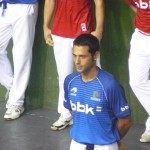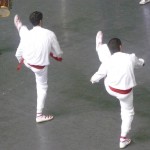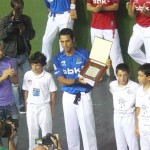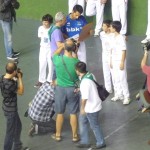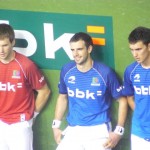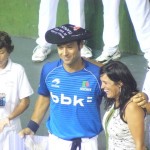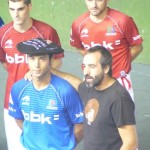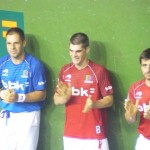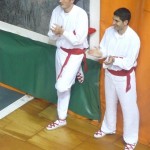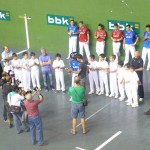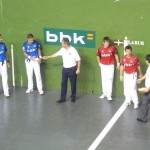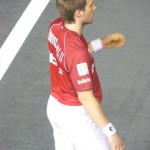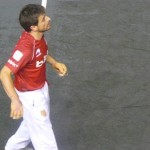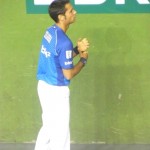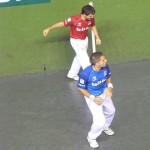In September I went to the Basque Country. I had only been there once before, on the holiday to Bilbao and San Sebastian in 2008 which so fuelled my passion, and had been meaning to return almost since the day I got home. This particular trip had been several months in the planning, borne of a series of musings with a friend on Twitter about how fabulous it would be to go to the Vuelta a Espana on its first visit to the Basque Country in so many years. Said friend is also a fan of pelota; we both watch the matches on ETB every Friday and Sunday and chat about them online, a weekly ritual to which we have become extremely attached. We therefore pondered on the possibility of combining it with a pelota match or two and gradually a hairbrain scheme became an actual plan, and then there were plane tickets and hotels booked. It was on!
Before alighting on Basque soil, we flew to Santander for the Vuelta stage on Peña Cabarga. You can read more about our cycling adventures in my two posts at Podium Café, here and here. We then took the bus to Bilbao, arriving at Termibus and from there our hotel at a late hour, exhausted from scaling the climb ahead of the cyclists in the blazing heat earlier in the day. Our pelota schedule had been planned out in advance, or as far in advance as the empresas allowed. Matches are rarely posted on their websites more than a week in advance, so it was all we could do to book our trip in the hope that the fixtures would be accessible. As the match listings trickled onto the internet, planning commenced with a vengeance and we quickly realised how very fortunate we had been, as all the venues, Bermeo, Lezama, Galdakao and Hondarribia, were relatively easily accessible. Much as a trip to Fortress Titin in Logroño would have been fun, it would have been a logistical nightmare!
Apart from the potential locations of the weekend’s matches, another of our chief worries was procuring tickets. Most matches are not sold out and are easy to get into on the door, but we were bothered by the possibility of not gaining entry to Saturday’s game in Galdakao as it was the farewell match of Oier Zearra and demand seemed high. Therefore, we used Thursday morning to catch the train to Galdakao and buy advance tickets. Easy. Or so we thought. Having worked out from where to catch the Euskotren, a new issue reared its head; Galdakao appeared on the maps to have two stations, Zuhatzu and Usansolo, and we had no idea which one was correct. When the train rumbled into Zuhatzu, we took the foolish and hasty decision that it just didn’t look right. However, when we arrived at Usansolo, it looked even less right. Having wandered in the direction in which we thought we ought to be going to reach the fronton for quite some time, we bit the bullet and turned on data roaming on the trusty iPhone, money escaping into a black hole as we scrolled. Yes, we were in an entirely separate town. And so we waited, and waited, for a train back in the direction from whence we had come. In the real Galdakao, the fronton was, thankfully, blindingly obvious.

Definitely a fronton
It was however less obvious how to buy tickets, there was no discernible box office, only a man in a bar who seemed understandably baffled, that two English types a) wanted pelota tickets, b) knew exactly when the match was, and c) knew who Oier Zearra was. The seats were indeed all sold out, but holding our prized standing tickets in our hands like precious and beautiful objects of awe, we returned with a hop and a skip to the station and awaited a train to Bermeo.

Waiting...and waiting...and waiting
The journey on the Euskotren to Bermeo was utterly beautiful, taking us through the archetypal verdant green valleys of Bizkaia to the emerging coastal marshes, the surfers’ paradise of Mundaka where the famous waves were rolling if rather small, and round the rocky outcrops to our destination. The station in Bermeo is right on the harbour and upon emerging, the beautiful vista of the little town with its bright fishing boats and blue sea meeting blue sky made me beam.

Bermeo
The fronton, Artza, sits in the centre of the panorama, but we had no idea of that at this point. So proceeded wild goose chase number two. In hindsight, we really should have printed out maps of how to get to frontons before leaving the UK, for our plan of finding a tourist information office and asking when we got there somewhat backfired. With a sigh, on went the iPhone yet again. Asegarce’s website helpfully gave us a postcode and Google Maps gave us a location. Bingo. Or so we thought. Having walked round and round the old town, up steps, down steps, back and forth, we realised that the GPS was seriously failing us and returned to the main square to ask a café owner to help us. With the help of our dubious Spanish, we ascertained that we had been right next to the fronton all along. And the fronton was next door to the Tourist Information. No matter, for we had plenty time, and went to buy some tickets from yet another slightly bemused local. We had also, in our panicked dash around the back streets, come to see what a truly lovely place Bermeo is.

A secluded square
I experienced a sense of overwhelming joy as we settled into a café with beer and pintxos, knowing that everything was sorted, and that I was going to see my first ever live pelota match in little over an hour. Walking into the fronton was almost surreal. I had seen the green walls and the white lines, heard the smack of the ball on hand and wall so many times via the internet that it seemed half normal and half totally bizarre to be there for real. When we entered, the players for the first match were warming up and I grinned both inside and out at the seemingly obvious realisation that these men were real people who actually existed, outside the confines of a computer screen in far off London. Artza is relatively small and we positioned ourselves a few rows back near the frontis, so very close to the action that it felt like we were an integral part of it. The first match saw a victory for Mendizabal III and Merino by 22 to 15 over Ongay and Ladis Galarza.

Mendizabal III prepares
My excitement was even more pronounced when the big guns came out to play, for match number two featured Martinez de Irujo and Zabaleta against Aritz Lasa and Zubieta. Zubieta has long been my hero in pelota terms and I make no secret of the fact that I was slightly over excited! As if that wasn’t enough, the great Irujo was almost in arm’s reach of my seat. As the match got underway, I was amazed by the speed and power of these players, something which fails to come across so readily on a computer screen. It is truly staggering how far and how hard the defenders hit the ball, and with how much venom the forwards attack it. Another thing which isn’t so obvious online is the noise when the hand hits the ball. This is a tough sport. The main match started tightly, the players trading blows until disaster struck with Lasa and Zubieta 10-8 up. Zabaleta, who looked mortified, accidentally hit Lasa on the head, and the forward fell to the ground in pain and shock before being helped off by his fellow players. Concerned murmuring swelled up in the crowd. Lasa was taken away in an ambulance for checks, and was susequently out of competition for several weeks with a cracked facial bone. With Lasa gone, the organisers hastily arranged a shortened Cuatro y Medio game between Irujo and Zubieta. This was a lot of fun. Until now, the crowd had had little over which to get exercised, but all it took was a bad call against Zubieta and the place erupted into a frenzy, the vast majority on the side of the wronged player. The atmosphere was infectious and thrilling, even though this was a match which counted for very little. Irujo eventually took advantage of some wayward serving from his opponent to win 12-8, but at the end both players were all smiles, having put on a highly enjoyable and high octane show.

Lasa and Zubieta warm up

Zubieta eyes up the ball

The great Irujo

Lasa ties his shoe

Zubieta and Lasa concentrate

Ready to play
The competition over, we left the fronton into a balmy evening and the fresh smell of the sea air. Bermeo’s summer fiesta was underway with music, food and general merriment but sadly we needed to return to Bilbao and the train would not wait. Already our thoughts turned to our packed programme for the following day. We had no idea quite how special Friday would turn out to be.

Goodbye Bermeo
Look out for Part 2, coming soon! Photos are all mine

